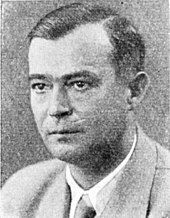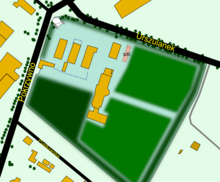Central Institute for Cancer Research (Reichsinstitut)
The Central Institute for Cancer Research, Reichsinstitut at the Reichsuniversität Posen , also called Reichsinstitut for Cancer Research , was a research institute established during the time of National Socialism in Nesselstedt (Polish: Pokrzywno ) near Posen . It was under the direction of the doctor Kurt Blome and, following comparable institutions in other countries, such as the National Cancer Institute founded in the USA in 1937, was supposed to function as the central institution for cancer research activities in the German Reich .
In addition to this civil research, work on biological weapons was also planned from the start . However, it is not yet known with certainty whether and to what extent such plans have actually been implemented in the institute. The institute existed from June 1942 until the conquest of Posen by the Red Army in early 1945 and remained largely unfinished with regard to its structural equipment and organizational structure.
Sponsorship and funding
The Central Institute for Cancer Research was sponsored by an association of the same name . In addition to the person authorized to set up the Kurt Blome Institute, this included the then President of the German Research Foundation (DFG) Rudolf Mentzel , the Secretary General of the Kaiser Wilhelm Society Ernst Telschow and the head of the research department of the Army Weapons Office Erich Schumann . An implementation originally planned by Blome as an institute of the Kaiser Wilhelm Society, however, did not materialize. Hanns Streit acted as managing director of the institute .
The financing of the institute, for which income from the association and state subsidies were initially earmarked, was later carried out by the Reich Research Council following a decision by its President Hermann Göring . From July 1943 to December 1944 the institute received a total of 1.5 million Reichsmarks . It had the status of a National Institute and was the official designation "Central Institute for Cancer Research, Imperial Institute at the State University of Poznan" of 1941 resulting from May 1944 State University of Poznan assigned.
Structural and organizational development
In March 1943, the Ursuline Monastery with the associated park in Nesselstedt near Posen was assigned to the Central Institute for Cancer Research as its headquarters . In addition, the use of other buildings in Nesselstedt as well as the premises of the University of Posen was planned.
Kurt Blome's ideas envisaged the establishment of six departments, namely a physiological-biological department with an attached tumor farm, a bacteriological and vaccine department, a gynecological-surgical department, an X-ray department, a cancer statistics department and a pharmacological department Department. In addition to the actual seat of the institute in the monastery, further buildings were to be built on the associated site, including a laboratory for animal experiments , an isolation station and an animal stable. The tumor farm for the breeding of experimental animals with tumors was a facility of the DFG and before the establishment of the Poznan Institute it was affiliated to the General Institute against Tumor Diseases of the Rudolf Virchow Hospital in Berlin .
The establishment of the Central Institute for Cancer Research proceeded more slowly than planned, so that two years after it was founded, only the Department of Cancer Statistics, located in the Medical Institute of the University of Poznan, and the Department of Pharmacology, located in the Poznan Kleist Barracks, were operational. For the other departments there were delays in the necessary new construction and renovation work. The institute's activities ended with the Battle of Poznan and the subsequent conquest of the city by the Red Army in the spring of 1945. A "Reich Research Institute for Frontier Areas of Medicine" planned as an alternative facility at the request of Kurt Blome from Heinrich Himmler in September 1944 as its location Geraberg was planned, was never realized due to the course of the Second World War .
The number of employees is not known for certain. The institute's files have not been found since the end of the war.
Bioweapons research
In addition to its official role in cancer research, the Central Institute for Cancer Research was also intended for work on biological weapons from the start . In this regard, it should be the most important institute in the German Reich. Because of its military importance, a three-meter-high wall was built around the institute, and a special command of the Waffen-SS was deployed to guard it and watchdogs were used. Investigations into the use of Yersinia pestis , the causative agent of the plague, were planned .
It is not known with certainty whether and to what extent work on biological weapons was actually carried out and whether human experiments suggested by Blome were also carried out. Kurt Blome denied when questioned at the Nuremberg Doctors' Trial that biological weapons experiments had ever been carried out in the institute, as the institute was still unfinished when the Red Army marched in. This information was later confirmed by the Polish side after a corresponding investigation .
Individual evidence
- ↑ a b c d In: Wolfgang Uwe Eckart, Stuttgart 2000, p. 76 (see literature)
- ↑ In: Erhard Geißler, Münster 1999, p. 523 (see literature)
- ^ Ernst Klee : The dictionary of persons on the Third Reich . Second edition. Fischer Taschenbuch Verlag, Frankfurt am Main 2007, ISBN 978-3-596-16048-8 , p. 475.
- ↑ In: Robert N. Proctor, Stuttgart 2002, p. 294 (see literature)
- ↑ In: Erhard Geißler, Münster 1999, p. 524 (see literature)
- ↑ In: Erhard Geißler, Münster 1999, p. 525 (see literature)
- ↑ Ulrike Scheybal: The General Institute against Tumor Diseases 1935-1945. In: Wolfgang U. Eckart (Ed.): 100 Years of Organized Cancer Research. Georg Thieme Verlag, Stuttgart 2000, ISBN 3-13-105661-4 , pp. 51-55
- ↑ In: Erhard Geißler, Münster 1999, pp. 543/544 (see literature)
- ↑ In: Erhard Geißler, Münster 1999, p. 528 (see literature)
- ↑ Dirty business: bacterial bombs, anthrax containing toothpaste, pest-infected rat armies - German researchers tested an arsenal of biological weapons during World War II. In: Der Spiegel . Issue 43/1993 of October 25, 1993, pp. 227-233
- ↑ In: Erhard Geißler, Münster 1999, p. 517 (see literature)
- ↑ In: Robert N. Proctor, Stuttgart 2002, p. 295 (see literature)
- ↑ In: Erhard Geißler, Münster 1999, p. 538 (see literature)
- ↑ In: Erhard Geißler, Münster 1999, p. 535 (see literature)
- ↑ a b In: Erhard Geißler, Münster 1999, pp. 542/543 (see literature)
literature
- Erhard Geißler : Colorado beetle and stomach cancer - What cancer research had to do with biological warfare. In: Wolfgang U. Eckart : 100 Years of Organized Cancer Research. Georg Thieme Verlag, Stuttgart 2000, ISBN 3-13-105661-4 , pp. 75–82 (on the Central Institute for Cancer Research, in particular pp. 75–77)
- Cancer research - not just for camouflage. In: Erhard Geißler : Biological weapons - not in Hitler's arsenals. LIT Verlag, Münster 1999, ISBN 3-82-582955-3 , pp. 517-550
- Secret Biological Weapons Research. In: Robert N. Proctor : Blitzkrieg against Cancer: Health and Propaganda in the Third Reich. Klett-Cotta, Stuttgart 2002, ISBN 3-60-891031-X , pp. 291-296
- The cancer institutes in the period 1900-1945. In: Gustav Wagner, Andrea Mauerberger: Cancer research in Germany. Prehistory and history of the German Cancer Research Center. Springer-Verlag, Berlin and Heidelberg 2012, ISBN 978-3-642-75021-2 , pp. 18–45; in particular section The Central Cancer Research Institute in Posen , p. 44


